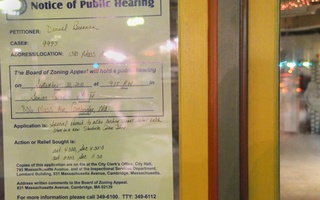The Armenian Holy Trinity Church's victorious court fight over city zoning laws has established a precedent which should free the University from compliance with any comparable ordinances, a master of the Middlesex Superior Court said yesterday.
Under the State Zoning Enabling Act, the University, as an educational institution, now qualifies identically with religious and charitable organizations in exemption from city zoning ordinances, according to William H. Lewis, Jr. '26.
Until the decision of the late Justice Charles A. Rome '17 in the Armenian Church case, it had not been clear whether the exemption would be broadened to apply to physical restrictions as well as to "use" restrictions.
Rome, in finding for the Church, sustained the "broad" interpretation of the Act set forth in Lewis' recommendations. Residents of the area near Sparks and Brattle Sts., where the Church had planned to build 22 feet above the 35-foot limit, had hoped for a strict reading of the law, leaving Cambridge the right to limit, physical proportions of the buildings.
The University favors the broad interpretation, a member of its law firm said, because such a decision means that Harvard can build as high as it wishes on any of its own land. The decision makes other physical restrictions equally invalid, Lewis said, and prevents Cambridge from establishing zoning laws which require parking facilities or sidewalk area next to University buildings.
According to Alan McClennan '38, Cambridge Planning Director, "Harvard has taken the position that it would like to comply with the zoning laws."
So far, none of the proposed or completed buildings of the Program for Harvard College violate zoning laws. Nonetheless, the ruling enables the University to retain its freedom of action.
The 11-story Leverett towers, which are built in a 100-foot, "residential B-3" zone, and Quincy House, built in a 65-foot C-3 zone, both conform to city laws.
The proposed ten-floor Health Center at Holyoke St. and Massachusetts Ave. would not exceed that block's 100-foot "business B" zone limit, either, McClennan said.
Consequently, the University could profit from the Superior Court decision only if it built on Brattle St. (a 35-foot, "residential A" district) or exceeded the 65 and 100-foot limits around the Yard.
Appellant Calls Precedent Weak
The University may not get a chance, however, to capitalize on its new-found freedom from zoning laws, according to Paul G. Counihan '39, counsel for the appellants. Counihan maintained that had he appealed to the Supreme Judicial Court of Massachusetts, the broad interpretation of the Enabling Act would have been overruled.
When the Church reached a compromise with local residents, however, Counihan agreed not to undertake the lengthy appeal proceedings.
Earlier, the Armenian Church had won from the Cambridge Appeals Board a special zoning variance which helped it to win its case. Because the ritual of the Church involves two additional side altars to represent the Holy Trinity, the variance permitted the extra height.
Read more in News
District 65 Says University Escalating Anti-Union TacticsRecommended Articles
-
Church and Theater Ensemble To Appeal Zoning Board VoteThe Cambridge Ensemble theater group and the church that has housed the group for four years will appeal in court
-
University Lawyers To Help Armenian ChurchIn an effort to establish the precedent of whether the University, as a "public charitable organization," is exempt from Cambridge
-
Cambridge Board Prevents Shelter From Moving Into Central SquareIn a controversial decision last night at City Hall, a Cambridge shelter for the homeless was denied permission to locate
-
Work Resumes on Lutheran ChurchWork was resumed last Monday after a delay of four months on the church being built behind the Indoor Athletic
-
 Another Starbucks May Open in Square
Another Starbucks May Open in Square -
Lesley's Art Institute of Boston Moving to PorterLesley University has received permission to relocate the AIB from Kenmore Square in Boston to Cambridge’s Porter Square.













